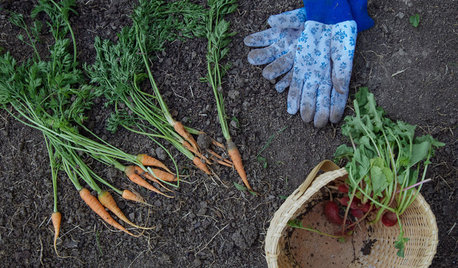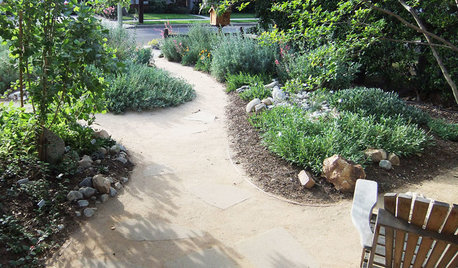Chanticleer Pear Trees Zone 5 City Success
abc222001
16 years ago
Featured Answer
Sort by:Oldest
Comments (41)
Carrie B
16 years agoRelated Discussions
How do you grow Winter Hardy Palm trees in zone 5
Comments (8)In zone 5, you can forget about the European Fan Palm. That one will die before spring. You MIGHT have success with the Windmill Palm. And if you're in zone5b, you are the most likely to have success with the Needle Palm. The European Fan Palm reaches heights of 5 to 10 feet, and if it outgrows your house, I'd personally recommend either moving to someplace warmer, or sell your European fan palm for maybe $30 to $40 and you can buy maybe 3-4 more of them. But the needle palm may be your best chance at a tropical garden if you can give it sufficient winter protection. Try the Trachycarpus Fortunei. Leave it in the pot, and outside until you start to notice cold damage(Remember, young plants are a lot less hardy then the mature specimens). If you see the leaves start to burn, BRING IT INSIDE IMMEDIATELY, and nurture it until the cold damage goes away. Try again in maybe 2 or 3 years(Repeat until it can live through december with minimal damage). These palms are hardy to 5*F when mature. When it seems okay for the environment you're in, plant it. To protect it in the winter, wrap the trunk in a blanket, or burlap. Stick some christmas lights(the ones that produce heat) along the entire trunk. Spray with freezepruf. It dehydrates your palm a little bit, decreasing the water content in the palm, thus making it more tough against freezes. Now, as for the needle palm, please visit this link: http://forums.gardenweb.com/forums/load/palms/msg081602271828.html?3360 Cheerio!...See MoreNew BnB Chanticleer Pear not leafing out?
Comments (4)youa re probably going to hear a lot about why you shouldnt have planted a pear ... i will le3ave it to the others ... sounds to me like it got zapped by a frost.. or a freeze ... any info aobut such from you .. is so ... it may have killed the buds .. an otherwise healthy tree.. and and usually will releaf ... how that all works on a ginormous transplant .. who knows... do stop scatching it ... once is enough ... give it 4 to 6 weeks ... what is your watering protocol ... how big was the BB ... bottom line.. only time will tell .. and you cant compare a transplant to other non transplants... nor even between such ... trees this big are field grown .. and when dug.. lose 95% of their roots .. and some are simply massacred .. since you cant really see what you are digging out ... but all you can do.. is give it time... unless your landscaper is willing to replace it .. and if he is.. plant anything other than a pear ... BTW.. what does he say about it .. ken...See MoreNeed advice on flowering trees for zone 5b
Comments (14)Ask this question on the New England forum also. Your part of MA has winter moths that can defoliate some kinds of trees more than others. There are a number of folks from zone 5 MA who visit the New England forum regularly and will chip in. I'd include a question about winter moth and other pest susceptibility in your post. There aren't winter moths in my area so I can't help with them, but I know that cherry trees around here are susceptible to a wide variety of pests and tend to be short-lived. There was a similar question there recently that might give you some ideas even though her size range started smaller than yours. You might want to consider whether you will want a mix of trees which will give you a longer period of interest and some protection from losing your entire shelter belt if there are disease or insect issues vs. having a more uniform look to your row of trees. You are making a good choice not to look at callery pears. They don't do well with the wet snows that often happen in New England. This is from last fall's Thanksgiving storm and the homeowner had to remove about half of 6 trees....See MoreZone 5a small tree selections
Comments (20)Three-Flowered Maple is an excellent small to mid-sized tree. Paperbark maple would be beautiful year-round. American Hornbeam is a great small tree with fall color and interesting winter form. The cultivar 'Native Flame' has a nice range of fall color. Magnolias like 'Leonard Messel' or 'Merill' are fantastic performers with outstanding blooms, foliage quality and yellow fall color. If going for the beech be sure there are others growing in your area- 5a is their limit and most cultivars will not make it below -20F. Northwind Maple is a Japanese x Korean cross that would be hardy enough for your area. Really great early leaf color and fall color. Royal Raindrops crabapple would give purple foliage color combined with nice flowers. Grows well even in quite harsh conditions. China Snow Pekin Lilac is another great small tree with flowers, bark, and decent yellow fall color. Would recommend it over regular Japanese Tree Lilac. Depending on the Birch you already have, Royal Frost & Dakota Pinnacle are also excellent selections with year-round interest. Lots of choices! And if you decide to go with a few conifers or even one your options expand greatly....See Morequirkyquercus
16 years agolucky_p
16 years agoDibbit
16 years agoken_adrian Adrian MI cold Z5
16 years agogardengal48 (PNW Z8/9)
16 years agoabc222001
16 years agoCarrie B
16 years agoDibbit
16 years agoIris GW
16 years agoEmbothrium
16 years agosuel41452
16 years agoCarrie B
16 years agosuel41452
16 years agogardengal48 (PNW Z8/9)
16 years agoFledgeling_
16 years agoquirkyquercus
16 years agorhizo_1 (North AL) zone 7
16 years agophyl345
16 years agoDibbit
16 years agoheptacodium
16 years agomdvaden_of_oregon
16 years agosuel41452
16 years agolucky_p
16 years agogardengal48 (PNW Z8/9)
16 years agoFledgeling_
16 years agosuel41452
16 years agoIris GW
16 years agorcnaylor
16 years agoradagast
16 years agoIris GW
16 years agospruceman
16 years agospruceman
16 years agowisconsitom
16 years agosuel41452
16 years agoquirkyquercus
16 years agoEmbothrium
16 years agopicea
16 years agotlbean2004
8 years agokrattigernm
6 years ago
Related Stories

FARM YOUR YARDMy Houzz: Backyard Farming for a Kansas City Family
A backyard garden provides a family of 5 with organic seasonal produce. Here's how they do it
Full Story
EDIBLE GARDENSWhy Grow Quince? For Beauty, Fragrance and Old-Time Flavor
Delightfully perfumed fruit and lovely spring blossoms make this apple and pear cousin worth a spot in the garden
Full Story
GARDENING GUIDES5 Things to Know About Watering Your Native Garden
Ensure the success of your new plantings with a smart approach to irrigation
Full Story
FARM YOUR YARDIf You Have Room for Only One Fruit Tree ...
Juice up a small garden with one of these easier-care or worth-the-effort fruit trees for a mild climate
Full Story
FALL GARDENING11 Trees for Brilliant Fall Color
Give your landscape the quintessential look of autumn with the red, orange and yellow leaves of these standouts
Full Story
SPRING GARDENING7 Spectacular and Practical Spring-Flowering Trees
Put on a beauteous show in the garden with a landscape tree awash in flowers — just do your homework first
Full Story
LANDSCAPE DESIGNPretty Trees for Patios, Paths and Other Tight Spots
Choose trees for their size, shape and rate of growth — or shape them to fit your space. Here's how to get started
Full Story
TREES7 Deer-Resistant Flowering Trees to Plant this Fall
If you live in a neighborhood with roaming deer, consider these beautiful trees that won't tempt hungry guests
Full Story
LANDSCAPE DESIGN7 Great Trees for Summer Shade and Fall Color
These landscape-pro faves straddle the seasons beautifully. Could one enhance your own yard?
Full Story
GARDENING GUIDESHow to Keep Your Citrus Trees Well Fed and Healthy
Ripe for some citrus fertilizer know-how? This mini guide will help your lemon, orange and grapefruit trees flourish
Full StorySponsored
Professional Remodelers in Franklin County Specializing Kitchen & Bath




lucky_p